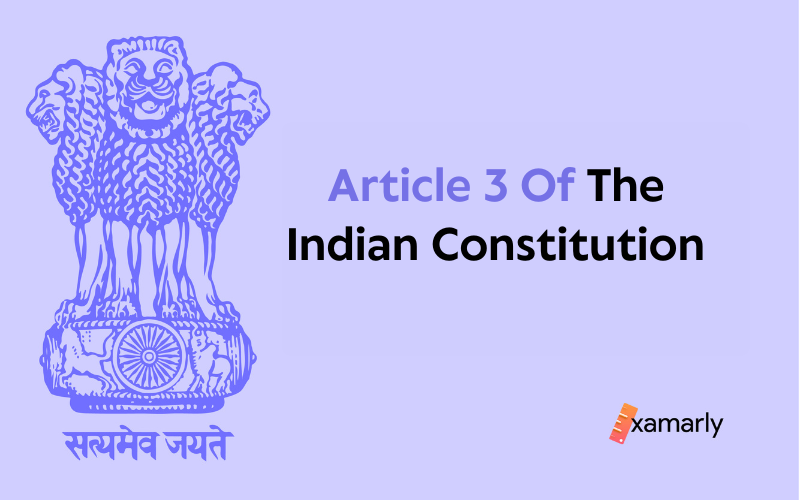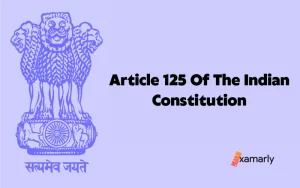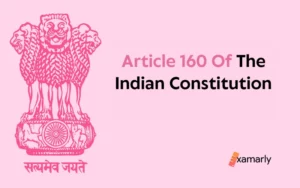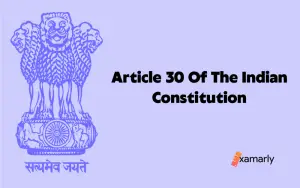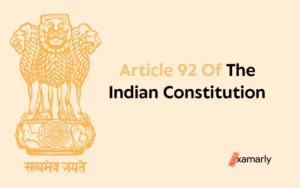Provinces were not thought to be permanent units at the time the Indian constitution was being written. Thus, they came up with the notion of creating new regions within the Indian Union. Article 3 of the Indian Constitution is one of the key documents that outline the formation of these new regions.
Article 2 gives the Parliament the real authority to admit new states into the Union of India. Article 3 provides the power to rename and change the boundaries of an existing state. Article 3 in the constitution of India is pertinent to understand how new states are formed from existing territories. Let’s go through this article to know more about this article and the debates related to this current form.
- Article 3 Of The Indian Constitution
- How Did It Come To Exist?
- Creation Of A New State
- Procedure For Changing The Name Of A State
- Supreme Court Verdict
- Case Of Telangana
- Comments Of Eminent Constitutional Philosophers
- Conclusion
- FAQs
- When Was The Third Article Of The Constitution Authored?
- What Is Article 3 Mostly About?
- What Exactly Is The Difference Between Article 2 And Article 3 In The Indian Constitution?
- Under Which Article Name Of The State can be changed?
- Which Amendment Amended The Article 3?
- When Are The Articles Covered Under The Part I Invoked?
- What Part I Of The Indian Constitution Deals With?
- What Is Article 3a Of The Constitution?
Article 3 Of The Indian Constitution
Article 3 of the Indian Constitution addresses the formation of new states. It also addresses changes to the state’s dimensions, boundaries, or names. Article 3 also provides the power to rename a state or merge two or more states together. That is, the Parliament may:
- (a) Form a new state by separating the territory from any existing state, by joining two or more states or parts of states, or by joining any territory to a part of any existing state
- (b) Expand the territory of any state
- (c) Reduce the size of any state
- (d) Change the borders of any state
- (e) Revise the name of any state
Explanation I – A Union territory is included in the term “State” in clauses (a) through (e) of this article, but not in the proviso.
Explanation II – The authority granted to Parliament by clause (a) involves the authority to combine a portion of one State or Union territory with another State or Union territory in order to create a new State or Union territory.
How Did It Come To Exist?
Creating a semblance of federalism in the country was a good idea. But, did you know that the semblance was not actually real? The powers that be were busy scheming up the next best thing. The writers of the Indian constitution did not believe that the provinces, regions, and rules throughout Bharat were stable, unchanging, and permanent. So they devised plans to create new regions within the Indian Union.
Creation Of A New State
Basically, Article 3 of the Indian Constitution states that the Parliament is the sole authority for forming a new state. It is necessary to note that the Assembly is not obligated to follow the views of the President or the Chief Minister. However, the Assembly does have to express its views before the prescribed intervals.
The Union Government is headed by the President of India. As such, he must approve any bill for creating or renaming a state. In fact, the Cabinet normally requests the President to recommend a state bill. It is not compulsory for the parliament to obligate to the chief’s views.
The President of India may specify a period of time for communicating his views. He also has the power to enable the amount to expire. Additionally, the Assembly must be referred to, allowing the President to voice his or her opinion in public. If the National Assembly fails to express its views at the prescribed intervals, the bill may be introduced in Parliament at the end of that term.
Also Read: Check out the linked article for the UPSC Exam Preparation from the table given below.
Procedure For Changing The Name Of A State
Changing a state’s name requires an amendment to the Constitution. This can be done through a bill introduced in Parliament. The President’s approval is needed before a bill can be introduced. This process is detailed in article 3 of the Indian constitution.
The state legislature first passes a resolution. This resolution is sent to the central government after it is passed. The state assembly (the people of the state) authorizes the state government to submit the matter to the Government of India for a name change. This modification may have an impact on the Hindi translations of the state’s name. Once the bill is passed, the state’s name will change. However, if the state’s assembly disagrees with the bill, it will not be enacted.
Except upon the President’s suggestion, no Bill for this purpose may be tabled in either House of Parliament. That is unless the President has referred the Bill to the Legislature of the affected State for comment within the timeframe specified in the reference or within any additional time frame the President may permit, in cases where the proposal in the Bill affects the area, boundaries, or name of any of the States.
Supreme Court Verdict
In 1960, a bill was introduced in the Indian Parliament proposing the formation of Maharashtra and Gujarat. The President passed on this Bill to the State Assembly to know their perception. Babulal Parante filed a petition in the High Court of Bombay against this Bill. His contention was that the said Act was passed in violation of Article 3 of the Constitution because the Legislature of Bombay was not given an opportunity to express its views on the formation of the composite State. The petition was denied by the High Court.
The court explains the provisions of Article 3 of the Constitution in this case. It mentions that the President should specify the time limit within which the state legislature must express its views; however, the President may extend the time limit. There is also nothing in the proviso that suggests Parliament must accept or act on the views of the State Legislature.
It is obvious that the Indian Constitution foresaw a scenario in which a state might refuse to express its opinion or express unfavorable views regarding the creation of a new state. As a result, the Indian Parliament was given full authority to make decisions even in the face of opposition from the State Assembly.
Case Of Telangana
Telangana had been a rather problematic region in terms of Indian state formation. In 1956, there were strong signs of Telangana wanting to be made a separate region. However, the situation of the time forced the region to be incorporated with Andhra State. To ease the fear of the residents of Telangana, Indian Union provided the people with legal guarantees protected by a regional committee. Over time, these proved to be unsuccessful. Soon, violent riots followed in 1969.
On December 9, 2009, the Minister of Internal Affairs of the Union of Bharat, P Chidambaram, announced the steps to form a replacement state in India known as Telangana. The Telangana bill was referred to the National Assembly rather than being passed within the institution as required by the Indian Constitution.
Comments Of Eminent Constitutional Philosophers
Prof. K.T. Shah was adamant that any proposal to change an existing state should come from the state legislature, not the parliament. KT Shah also believed that Article 3 undermined federalism by giving the Centre ‘unnecessary’ and ‘excessive’ power. According to K Santhanam, it would be challenging to persuade a state to endorse a minority’s demand for separate states, which would stifle their demands.
Conclusion
Using article 3 of the Indian constitution as a reference, you can look for the steps that the Indian Government took to create a new State. You can also find out how the name-changing process for a State was. You can also find out what the Supreme Court has said about this procedure. All these will help the current generation understand the purposes of article 3 and the role of the union government in its administration.
FAQs
When Was The Third Article Of The Constitution Authored?
Draft Article 3 was debated on the 17th, 18th, and 13th of November 1948. This article provides the provisions for creation of new states from the existing states or territories along with the alteration boundary and changes of the name of the states.
What Is Article 3 Mostly About?
Article 3 in the constitution of India is about Creating states from existing territories along with changes to boundaries or names of states.
What Exactly Is The Difference Between Article 2 And Article 3 In The Indian Constitution?
It is obvious from a comparison of these clauses that Article 2 addresses the formation or admission of a new state from outside the Indian Territory.
Article 3 allows the parliament some authority to alter the territorial boundaries of existing states while also giving the right to combine existing states to form a new state.
Under Which Article Name Of The State can be changed?
According to Article 3, Parliament has the authority to change any State’s boundaries, name, or area by law. It can also raise or decrease a State’s territory.
Which Amendment Amended The Article 3?
On December 24, 1955, the Constitution (fifth amendment) Act, 1955 changed the original provision of Article 3.
When Are The Articles Covered Under The Part I Invoked?
When West Bengal was given a new name and for the creation of relatively new states like Jharkhand, Chattisgarh, or Telengana, the articles of Part I was applied.
What Part I Of The Indian Constitution Deals With?
Part I is the compilation of laws pertaining to the Constitution of India with respect to Union Territories and States. It comprises 4 articles that revolve around the Union States and Territories of India.
What Is Article 3a Of The Constitution?
Article 3a states that the Parliament may pass legislation to create a new State by separating the territory from an existing State, joining two or more States or parts of States, or combining any area with a portion of an existing State.


